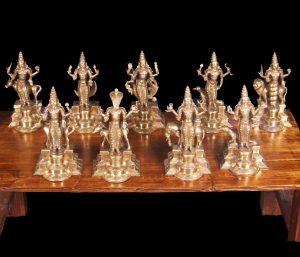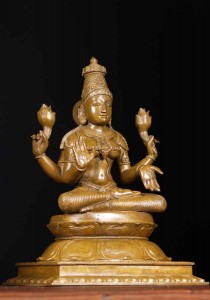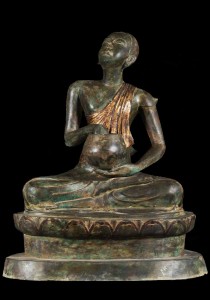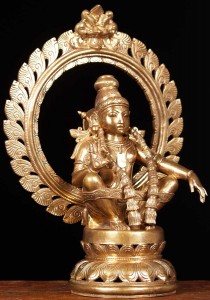
Sabarimala in Kerala, is the site of the most famous Ayyappa temple in the world and is visited by more than 50 million devotees each year, from different parts of the world regardless of their caste, creed and religion.The temple is situated in the middle of a dense forest, and the devotees need to take a 41 day penance, carry irumudi and ascended 18 steps to seek the blessings of the Lord. The story of Ayyappa is depicted in the famous purana, named Bhoothanaathopaakhyaanam.
Birth of Lord Ayyappa: The demon Mahishasur was killed by Goddess Durga and the sister of Mahishasur, Mahishi decided to avenge for her brother’s death. Lord Brahma was forced to appear before her and granted her wish. She demanded that she should be killed by the son born for the couple Lord Shiva and Lord Vishnu, thinking that it is impossible. Thinking herself indestructible she began to unleash her cruel deeds to execute the poor saints and people.
Mohini: Mohini was Lord Vishnu’s one and only incarnation in female form. Her goal was to settle the dispute between devas and demons that aroused during the churning of the ocean (ksheer sagar).
Enchanted by the beauty of Mohini, Lord Shiva fell in love with her and a beautiful son was born to them.
Rajasekhara, the king of Pandalam, was a great devotee of Lord Shiva and he along with his wife used to pray to the Lord for a son as they wanted an heir to the throne. One day, after hunting, while he was enjoying the beauty of nature near the banks of river Pampa, heard the cry of a baby from the dense forest. Even though, the king was happy to see the child, he hesitated to take the child to the palace, but a sage appeared and informed the king that the child is a gift from Lord Shiva and you can take him with you. As the child was wearing a jewel around his neck he was named “Manikanda”, “mani” meaning bell and “kanda” meaning neck, and in their happiness the King took the child home. The queen was also very happy and accepted him as their child.
The child was gifted and mastered in all the Vedas and arts of warfare quickly. He grew up as a graceful and charming, talented and courageous warrior. The Guru soon recognized the divine powers of Ayyappa (Another name of Manikanda) and asked to bless his blind and deaf son with sight and speech as Ayyappa came to offer ‘gurudakshina‘ (fee to his guru).
Royal Conspiracy: In the meantime, the king and the queen were blessed with a baby boy, whom they named as Raaja Rajan. The prime minister was much disappointed to know that the king is planning to crown Ayyappa as the next king, since he thought that he would be able to rule the kingdom after the death of Raja. He began to think of different ways by which he can deny Ayyappa from being the next king and met the queen to evoke negative feelings in her mind against Ayyappa being the king when she has her own child, who has the birth right to be the next king.
The minister was able to convince the queen, and she agreed to plot with him in his plans for Raaja Rajan to become the next king. As a part of the conspiracy, the queen began to act as if she was suffering from headaches and stomach pain. The king, who was worried, called for experienced and well known physicians to cure her, but none of them could do anything to relieve her from the pain. The minister brought in a fake physician who informed the king that the queen can be saved only by using the milk of a lactating tigress.
No one came forward to gather the milk despite of the great offers from the king and at last Ayyappa came forward, but the king did not give him the permission to go. Somehow, Ayyappa persuaded the king and got his blessing and left into the forest. When Ayyappa starts His journey to the forest to collect milk from the tigress, the king collected all the necessary things to meet Ayyappa’s requirements during the long journey and bundled them in a cloth bag. It came to be known as irumudi and today the pilgrims use this type of cloth bag to carry things while traveling to Ayyappa’s temple in Sabarimala. It is believed that carrying irumudi symbolizes Ayyappa’s journey to the jungle and only the pilgrims who carry the irumudi are permitted to ascend the 18 holy steps to reach sannidanam.
On reaching the forest, Ayyappa came to know about the atrocities of the ferocious Mahishi and decided to meet her in a duel near the river, Azutha, where he lifted her by the horns. Mahishi was able to recollect her original beautiful form by the divine touch of Lord Ayyappa. She pleaded Ayyappa to marry her, but he refused to do as he said that there a lot of people who need his help. However, he promised to marry her if anyone does not need his help. Now this Mahishi is worshiped as Goddess Maaligappurath-amma in Sabarimala. Ayyappa is thus referred to as the celibate god of Kerala because he refuses to marry the beautiful Mahishi.
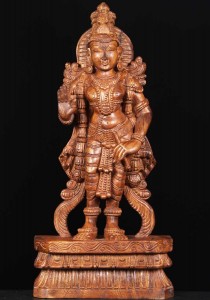
Comfort to the king: The death of Mahishi was celebrated by everyone and all the Gods from the heaven came to earth to show their courtesy towards him. Indra, the king of heavens, disguised himself as a tiger and all the female Goddess as tigresses and accompanied Lord Ayyappa to his palace. All the people, including the king were surprised to see the multitude of tigers and a saint appeared before him to reveal the real identity of lord Ayyappa. The king begged for pardon, as he was unaware of the conspiracy of the queen and minister. The king was ready to punish them, but Ayyappa prevented him from it, and agreed to the wish of the king that he will stay in the kingdom forever. The Lord pointed an arrow and shot it, asked the king to build a temple for him where it landed. The arrow fell on Sabarimala or the Mountain of Sabari. A temple was built at the place where they found the arrow, and it is believed that Lord Ayyappa stays in the temple showering blessings on the devotees who came to visit him through the tough trekking path barefooted.
Pilgrimage to Sabarimala: The Sabarimala temple has so many specialties, it is situated in the middle of a dense forest and can be reached through a five Km long trekking path. The devotees’ identity is denoted by the color of the dress they wear. The temple restricts the entry of women between the age group of 10 to 50 and the devotees have to observe 41 days penance, rigorous fasting to seek the blessing of the Lord. They have to be abstained from all the worldly pleasures and live as a hermit to climb the eighteen steps to reach sannidhanam. It is believed that the Lord will descend to earth in the form of light on a special day known as Makar Sankranti or Pongal to bless his devotees. A pilgrimage to the Sabarimala makes you realize the truth “ThatTvam Asi” (You are that supreme Consciousness”). He is known as Dharma Saastha (the Lord in the world) and Hari-Hara Puthra ( Son of Lord Vishnu and Shiva).
Posture of Lord Ayyappa: It reflects that of a Yogi.
The crown shows that he was a king of all kings.
The right hand is held in the Abhaya mudra which symbolizes the protection offered by the Lord to His true devotees and the fearlessness they fell after surrendering everything to the Lord. This posture is also known as Chinmudra or Njaana Mudra.
The left hand, with all five fingers, points downwards, symbolizes that he is the creator and controller of all the 5 elements of which the earth is made of.
The lotus pedestal indicates the world we live in and the lotus symbolizes the different stages through which our life passes.
The garland of the Lord is unique and symbolizes grace.
The Lord’s legs are symbolic of a wandering mind with the belt around them calming the wandering mind.
Why did Lord Ayyappa forbid the king from taking action against the queen and the minister’s machinations?

